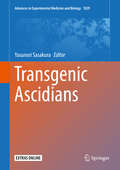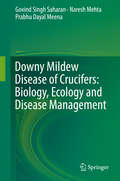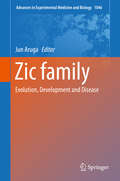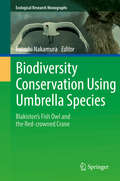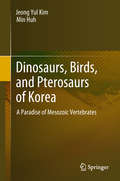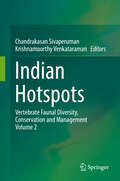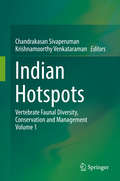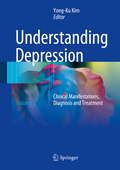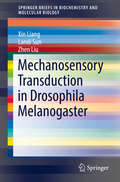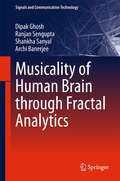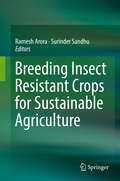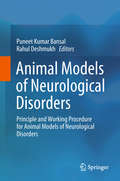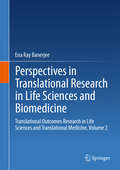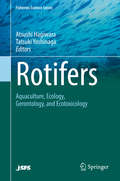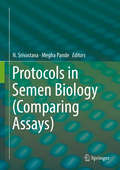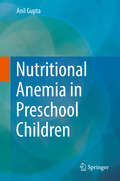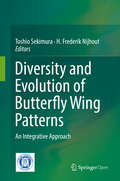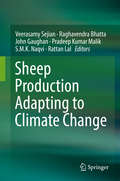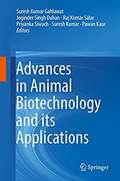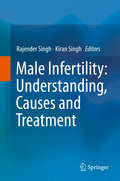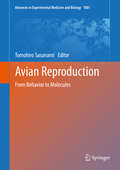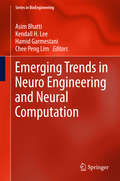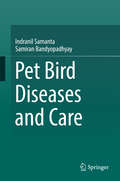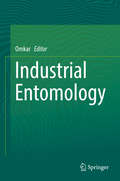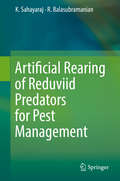- Table View
- List View
Transgenic Ascidians (Advances in Experimental Medicine and Biology #1029)
by Yasunori SasakuraThis book comprehensively describes the transgenesis techniques and applied experimental methods in ascidians including enthusiastically developed original devices in addition to concrete examples of developmental biology studies. Ascidians have been one of the most important model animals in developmental biology for studying molecular and cellular processes underlying formation of the chordate body plan. Transgenic techniques such as microinjection, electropolation, cis-element analysis and application, and TALENs and CRISPR/Cas9 have been developed in ascidians for more than 20 years, and now many applied methods, some of which are unique in ascidians, have been accumulated. Those extensive technological innovations, such as cell isolation, cell labeling, germ-line transformation, marker transgenic lines, and the experimental systems for studying notochord formation and nervous system, are exceptional particularly in marine invertebrates. This book is useful for ascidian researchers to quickly access the techniques in which they are interested as well as to compare each technology to become familiar with specialized tips, and for biologists of other organisms to learn the unique techniques and ingenious attempts specific to ascidians. Providing detailed and easily understandable descriptions of techniques, the book will inspire ascidian specialists to improve their techniques, encourage anyone wanting to begin studying ascidians, and enable readers to immediately apply the techniques to the organisms they research.
Downy Mildew Disease of Crucifers: Biology, Ecology and Disease Management
by Govind Singh Saharan Naresh Mehta Prabhu Dayal MeenaThe book reviews key developments in downy mildew research, including the disease, its distribution, symptomatology, host range, yield losses, and disease assessment; the pathogen, its taxonomy, morphology, phylogeny, variability, sporulation, survival and perpetuation, spore germination, infection, pathogenesis, seed infection, disease cycle, epidemiology, forecasting, and fine structures. The book also elaborates the mechanisms of host resistance (biochemical, histological, genetic, and molecular, including cloning and the mapping of R-genes), disease resistance breeding strategies, and the genetics of host-parasite interactions. It explores disease management based on cultural, chemical, biological, host resistance, and integrated approaches; and provides suggestions for future research areas. This book offers a comprehensive guide to an economically important disease, reviewing in detail the extant body of literature. Divided into 16 chapters, each of which includes a wealth of photographs, graphs, histograms, tables, figures, flow charts, micrographs etc., it represents an invaluable source of information for all researchers, teachers, students, industrialists, farmers, policymakers, and all others who are interested in growing healthy and profitable cruciferous crops all over the world.
Zic family: Evolution, Development and Disease (Advances in Experimental Medicine and Biology #1046)
by Jun ArugaThis book provides a comprehensive overview of ZIC-family research. Part1 summarizes the ZIC family in animal evolution and development and presents an overall picture of the ZIC family gene structure in eumetazoan animals, providing an evolutionary hypothesis and reviewing the studies on the role of ZIC family proteins in developmental processes for each animal model. Part 2 shows that the ZIC family are the causative genes for developmental disorders, and discusses the role of the ZIC family in stem cell biology. It also presents studies on the ZIC family in the medical biology field. This interdisciplinary book is a valuable resource not only for those people directly involved in ZIC-family-related research, but also researchers in diverse research fields who are interested in the latest advances in biology and medicine.
Biodiversity Conservation Using Umbrella Species: Blakiston's Fish Owl and the Red-crowned Crane (Ecological Research Monographs)
by Futoshi NakamuraThis book focuses on Blakiston’s fish owl and the red-crowned crane as umbrella species. Healthy river, riparian and wetland ecosystems are necessary to maintain the populations of the two species. Both species have been revered by people since ancient times, but both are currently listed as endangered because of their small population sizes. The population decline of the two species can be mainly attributed to the degradation of the natural riparian and wetland habitats, which is associated with land use development.The populations of the two species are now recovering in Japan due to recent conservation and reproduction efforts, but the genetic diversity of the two species are still low due to previous bottleneck effects. To develop conservation and dispersal plans to establish the species over the East Asian mainland and on the island of Hokkaido, basic information, such as their regional distribution, genetic diversity, food availability, reproductive traits, and nesting, breeding, rearing, and commuting habitat, is essential. The intensive, collaborative studies conducted in Japan and Russia has clarified the status quo and the ecology of the two species. This is the first book that comprehensively compiles the above information for the mainland and island populations. In addition, it verifies their suitability as umbrella species of an ecosystem and the possibility of their future population expansion, taking into account changes in land use in Hokkaido, which is about to experience a dramatic decline in human population. As such, the book provides valuable information for students who wish to learn about these beautiful symbolic creatures, for NGOs engaged in conservation activities, and for managers who are involved in creating conservation plans and implementing restoration projects.
Dinosaurs, Birds, and Pterosaurs of Korea: A Paradise of Mesozoic Vertebrates
by Jeong Yul Kim Min HuhThis is the first academic book about the dinosaurs, birds and pterosaurs of Korea, one of the richest and most exciting regions on earth for the study of vertebrate ichnology. Many ichnogenera appear indigenous to Korea, and based on present evidence there is nowhere else in the world where such densities and diversity of vertebrate tracks have been reported. Many sites also reveal the highest density of bird and dinosaur track levels in the world. The book describes the significant advances in Cretaceous vertebrate ichnology and dinosaur research made in Korea over the past twenty years. Several dinosaur fossil sites have been excavated, and unique vertebrate fossils including dinosaurs and pterosaurs have been discovered. This landslide of discovery has resulted in a proliferation of papers on vertebrate tracks and remains from the Cretaceous of South Korea and the growing recognition that as a region it reveals multiple track-rich sequences of unique quality and scientific utility. Because of the outstanding ichnological resources in this region it has been dubbed the Korean Cretaceous Dinosaur Coast (KCDC), and many sites of national and international significance have been designated as national natural monuments of Korea. This book is written for geologists, paleontologists, ichnologists, geology and earth science students, and earth science teachers at high school, as well as the general reader interested in ancient life including the dinosaurs, birds, and pterosaurs of Korea. The goal of this book is to provide readers with a scientific understanding of Mesozoic life flourishing in the Korean Peninsula. To facilitate easy comprehension, the book contains many sketches, graphs, diagrams, photographs and tables and is supported by a comprehensive glossary.
Indian Hotspots: Vertebrate Faunal Diversity, Conservation and Management Volume 2
by Chandrakasan Sivaperuman Krishnamoorthy VenkataramanThis book offers a comprehensive account of India’s four biodiversity hotspots: the Himalaya, Indo-Burma, Western Ghats and Sri Lanka and Andaman and Nicobar Islands. With a focus on tropical rainforests, it includes more than 30 chapters covering different vertebrate fauna e.g. fishes, amphibians, reptiles, birds, and mammals, as well as topics such as conservation and management aspects.Written by experts in the field of biodiversity conservation and management, it offers ample new insights into a number of subjects related to the faunal communities of tropical forest ecosystems, providing a valuable resource for conservationists and researchers in the field of flora and fauna diversity.
Indian Hotspots: Vertebrate Faunal Diversity, Conservation and Management Volume 1
by Chandrakasan Sivaperuman Krishnamoorthy VenkataramanThis book offers a comprehensive account of India’s four biodiversity hotspots: the Himalaya, Indo-Burma, Western Ghats and Sri Lanka and Andaman and Nicobar Islands. With a focus on tropical rainforests, it includes more than 30 chapters covering different vertebrate fauna e.g. fishes, amphibians, reptiles, birds, and mammals, as well as topics such as conservation and management aspects. Written by experts in the field of biodiversity conservation and management, it offers ample new insights into a number of subjects related to the faunal communities of tropical forest ecosystems, providing a valuable resource for conservationists and researchers in the field of flora and fauna diversity.
Understanding Depression: Volume 2. Clinical Manifestations, Diagnosis and Treatment
by Yong-Ku KimThis book, in two volumes, focuses on contemporary issues and dilemmas in relation to depression. The aim is to equip readers with an up-to-date understanding of the clinical and neurobiological underpinnings of depression, the clinical manifestations, and the development of more effective treatments. This second volume is devoted specifically to clinical and management issues. Readers will find detailed information on a wide range of frequently encountered and more complicated clinical presentations, with examination of risk factors and links to other conditions. Diagnostic aspects, including progress toward biological classification and the role of neuroimaging, are explored. Current trends in therapy are examined at length, drawing on the latest evidence and covering not only antidepressant medications but also the roles of neurostimulation, combined pharmacotherapy and psychotherapy, mindfulness-based cognitive therapy, and complementary and alternative medicine. The companion volume is dedicated to the underlying biomedical and neurobiological basis of depression. Understanding Depression will be an excellent source of information for both researchers and practitioners in the field.
Mechanosensory Transduction in Drosophila Melanogaster (SpringerBriefs in Biochemistry and Molecular Biology)
by Xin Liang Landi Sun Zhen LiuThis book offers an essential introduction for all graduate students and researchers who are working on or interested in mechanotransduction using fruit flies as their model organisms. Designed for accessibility, it follows a simple five-chapter structure, beginning with a general introduction to mechanotransduction in physiology (Chapter 1) and some basic considerations on the principles behind mechanotransduction processes (Chapter 2). In turn, Chapters 3, 4 and 5 focus on mechanoreceptors in Drosophila melanogaster. Chapter 3 explains how the fly’s mechanosensitive cells (i.e. mechanoreceptors) contribute to its daily life, while Chapter 4 explores the ultrastructural and mechanical basis for the working mechanisms of various fly mechanoreceptors. Lastly, Chapter 5 elaborates on the structure, function and physiology of mechanosensitive molecules in fly mechanoreceptors. Accordingly, the book provides an overall framework, helping readers understand mechanosensory transduction, from the physiological level to the molecular level.
Musicality of Human Brain through Fractal Analytics (Signals and Communication Technology)
by Dipak Ghosh Ranjan Sengupta Shankha Sanyal Archi BanerjeeThis book provides a comprehensive overview of how fractal analytics can lead to the extraction of interesting features from the complex electroencephalograph (EEG) signals generated by Hindustani classical music. It particularly focuses on how the brain responses to the emotional attributes of Hindustani classical music that have been long been a source of discussion for musicologists and psychologists. Using robust scientific techniques that are capable of looking into the most intricate dynamics of the complex EEG signals, it deciphers the human brain’s response to different ragas of Hindustani classical music, shedding new light on what happens inside the performer’s brain when they are mentally composing the imagery of a particular raga. It also explores the much- debated issue in the musical fraternity of whether there are any universal cues in music that make it identifiable for people throughout the world, and if so, what are the neural correlates associated with the universal cues? This book is of interest to researchers and scholars of music and the brain, nonlinear science, music cognition, music signal processing and music information retrieval. In addition, researchers in the field of nonlinear biomedical signal processing and music signal analysis benefit from this book.
Breeding Insect Resistant Crops for Sustainable Agriculture
by Ramesh Arora Surinder SandhuThis book reviews and synthesizes the recent advances in exploiting host plant resistance to insects, highlighting the role of molecular techniques in breeding insect resistant crops. It also provides an overview of the fascinating field of insect-plant relationships, which is fundamental to the study of host-plant resistance to insects. Further, it discusses the conventional and molecular techniques utilized/useful in breeding for resistance to insect-pests including back-cross breeding, modified population improvement methods for insect resistance, marker-assisted backcrossing to expedite the breeding process, identification and validation of new insect-resistance genes and their potential for utilization, genomics, metabolomics, transgenesis and RNAi. Lastly, it analyzes the successes, limitations and prospects for the development of insect-resistant cultivars of rice, maize, sorghum and millet, cotton, rapeseed, legumes and fruit crops, and highlights strategies for management of insect biotypes that limit the success and durability of insect-resistant cultivators in the field. Arthropod pests act as major constraints in the agro-ecosystem. It has been estimated that arthropod pests may be destroying around one-fifth of the global agricultural production/potential production every year. Further, the losses are considerably higher in the developing tropics of Asia and Africa, which are already battling severe food shortage. Integrated pest management (IPM) has emerged as the dominant paradigm for minimizing damage by the insects and non-insect pests over the last 50 years. Pest resistant cultivars represent one of the most environmentally benign, economically viable and ecologically sustainable options for utilization in IPM programs. Hundreds of insect-resistant cultivars of rice, wheat, maize, sorghum, cotton, sugarcane and other crops have been developed worldwide and are extensively grown for increasing and/or stabilizing crop productivity. The annual economic value of arthropod resistance genes developed in global agriculture has been estimated to be greater than US$ 2 billionDespite the impressive achievements and even greater potential in minimizing pest- related losses, only a handful of books have been published on the topic of host-plant resistance to insects. This book fills this wide gap in the literature on breeding insect- resistant crops. It is aimed at plant breeders, entomologists, plant biotechnologists and IPM experts, as well as those working on sustainable agriculture and food security.
Animal Models of Neurological Disorders: Principle and Working Procedure for Animal Models of Neurological Disorders
by Puneet Kumar Bansal Rahul DeshmukhThis book introduces undergraduate, postgraduate and research students and scientists to animal models of neurological disorders, along with their working principle and brief procedures. Addressing all the disorders related to the central nervous system (CNS) in a single platform, on the basis of various literature surveys it describes different procedures to induce a single disease with the help of toxins/chemicals. It also includes numerous protocols for inducing single neurological diseases, thus fulfilling an urgent need for a book that makes specific procedures for neurological disorders available, so that specific disease can be induced in laboratories according to the availability of resources. Further, it acquaints readers with the pathological changes that occur in a particular neurological disorder, which reflect specific signs and symptoms of any particular disease, and examines how they affect everyday life. It is a valuable resource for researchers aiming to eradicate or improve neurological disorders by testing the benefits of different drugs.
Perspectives in Translational Research in Life Sciences and Biomedicine: Translational Outcomes Research in Life Sciences and Translational Medicine, Volume 2
by Ena Ray BanerjeeThis book is a collation of translational research outcomes in the area of life research, which was formerly used mainly for academic pursuits. The studies described focus on innovative interdisciplinary approaches to unraveling problems in life sciences and biomedicine using biodiversity exploration and green technology. The techniques and models presented offer a ready reckoner for researchers in academic institutions and industry, and also provide valuable insights into fundamental research. The book discusses topics such as tissue engineering to create lineage-specific cells for tissue-specific regeneration; how combination cultures of commensalistic bacteria can help boost immunity; development of functional food from natural products from plant, animal, and microbial sources in the nutraceuticals domain; as well as synthesis and mechanisms in nanomedicine and nanoscaffolds in biomedicine. The studies and discourses described touch upon topics that explore biodiversity for the development of disease models, toxicity studies, developmental studies, and harvesting of bioactive compounds for alternative income generation and poverty alleviation, and as a result, bring about economic and ecologic sustainability. This multidimensional and multidisciplinary book focuses on tissue-specific targeting by nanodrugs, development of bioengineering formats for cell- based, nutraceutical-based, functional-food-based and antibody-based green therapy designed tackle multifaceted diseases and syndromes.
Rotifers: Aquaculture, Ecology, Gerontology, and Ecotoxicology (Fisheries Science Series)
by Atsushi Hagiwara Tatsuki YoshinagaThis book highlights the latest advances in rotifer studies in various fields including aquaculture, ecology, gerontology and ecotoxicology. The genus Brachionus are an indispensable type of zooplankton, having served as an initial live food for marine larval rearing since the 1960s. Their mass culture techniques have been intensively studied, and some essential achievements have been made – regarding high density culture, employment of valuable dietary algae, automated culture systems, and effective production of resting eggs. These have in turn supported stable and efficient aquatic seedling production for numerous important marine fish species including flounder, sea bream, and bluefin tuna. Further, this group is considered to be a suitable model for studying various aspects in ecology. A series of aquaculture and basic science studies have significantly advanced our understanding of the life history evolution. The studies in these two fields are closely linked, and provide readers with comprehensive information on how rotifers are now being employed in biological investigations.
Protocols in Semen Biology (Comparing Assays)
by N. Srivastava Megha PandeThis book on protocols in semen biology is a compilation of 20 chapters written by 15 experts from 5 Indian Council of Agricultural Research institutions, focusing on the basics of various procedures in semen biology with applications in animal and other allied sciencesThe information is presented in simple language with illustrative figures and colour microphotographs, making it understandable for readers of every level. It highlights recent findings, the comparative analysis of assays, protocols, points to ponder, background information and major references, and also compares various assays for evaluating a seminal parameters. The book provides a comprehensive resource for beginners, as well as academics, investigators and scientists of animal semen biology and relevant fields. Further, it offers valuable teaching material.
Nutritional Anemia in Preschool Children
by Anil GuptaThe book highlights intricate predisposing factors for pathogenesis of nutritional anemia. It delivers valuable information related to this public health hazard influencing the nutritional health of preschool children. The book is valuable for readers in diverse fields to gain insight of the concept of nutritional anemia in preschool children. Additionally, book furnishes clinical and laboratory methods in a comparative way to assess nutritional anemia. Impact of the disorder on health of preschool children has been covered in a simple language. The book mentions need for interventional strategies for the management of nutritional anemia. Infants, preschool children and women during pregnancy and lactation are highly susceptible to dietary deficiency of iron, folic acid and cyanocobalamin leading to comparatively, higher predisposition to development of nutritional anemia. The condition has myriad of ill effects on nutritional health of preschool children.
Diversity and Evolution of Butterfly Wing Patterns: An Integrative Approach
by Toshio Sekimura H. Frederik NijhoutThis book facilitates an integrative understanding of the development, genetics and evolution of butterfly wing patterns. To develop a deep and realistic understanding of the diversity and evolution of butterfly wing patterns, it is essential and necessary to approach the problem from various kinds of key research fields such as “evo-devo,” “eco-devo,” ”developmental genetics,” “ecology and adaptation,” “food plants,” and “theoretical modeling.” The past decade-and-a-half has seen a veritable revolution in our understanding of the development, genetics and evolution of butterfly wing patterns. In addition, studies of how environmental and climatic factors affect the expression of color patterns has led to increasingly deeper understanding of the pervasiveness and underlying mechanisms of phenotypic plasticity. In recognition of the great progress in research on the biology, an international meeting titled “Integrative Approach to Understanding the Diversity of Butterfly Wing Patterns (IABP-2016)” was held at Chubu University, Japan in August 2016. This book consists of selected contributions from the meeting. Authors include main active researchers of new findings of corresponding genes as well as world leaders in both experimental and theoretical approaches to wing color patterns. The book provides excellent case studies for graduate and undergraduate classes in evolution, genetics/genomics, developmental biology, ecology, biochemistry, and also theoretical biology, opening the door to a new era in the integrative approach to the analysis of biological problems.This book is open access under a CC BY 4.0 license.
Sheep Production Adapting to Climate Change
by Veerasamy Sejian Raghavendra Bhatta John Gaughan Pradeep Kumar Malik S.M.K Naqvi Rattan LalThis book presents a compilation of the latest findings from reputed researchers around the globe, covering in detail climate change and its effects on sheep production. In the current global climate change scenario, information related to its impact on livestock agriculture is lacking.The negative impacts of climate change are already being felt by all livestock species. Further, the mitigation and amelioration strategies that are applicable for one species may not hold true for another. As such, concerted research efforts are needed to identify species-specific strategies for mitigation and adaptation. With that goal in mind, this book is the first of its kind to gather comprehensive information pertaining to the impact of climate change on various aspects of sheep production. It also sheds light on the role of sheep with regard to the global greenhouse gas pool. The book highlights the status quo of sheep production from climate change perspectives and projects the significance of adapting future sheep production to the challenges posed by climate change. It addresses in detail the various adaptations, methane mitigation and amelioration strategies needed to sustain sheep production in the future. In addition, the book presents development plans and policies that will allow the sheep industry to cope with current climate changes and strategies that will lessen future impacts. Bringing together essential information prepared by world-class researchers hailing from different agro-ecological zones, this book offers a unique resource for all researchers, teachers and students associated with sustaining the sheep production in the face of global change.
Advances in Animal Biotechnology and its Applications
by Suresh Kumar Gahlawat Joginder Singh Duhan Raj Kumar Salar Priyanka Siwach Pawan KaurThis book explores the recent advancements in cutting-edge techniques and applications of Biotechnology. It provides an overview of prospects and applications while emphasizing modern, and emerging areas of Biotechnology. The chapters are dedicated to various field of Biotechnology including, genome editing, probiotics, in-silico drug designing, nanoparticles and its applications, molecular diagnostics, tissue engineering, cryopreservation, and antioxidants. It is useful for both academicians and researchers in the various disciplines of life sciences, agricultural sciences, medicine, and Biotechnology in Universities, Research Institutions, and Biotech companies. This book provides the readers with a comprehensive knowledge of topics in Genomics, Bionanotechnology, Drug Designing, Diagnostics, Therapeutics, Food and Environmental Biotechnology. The chapters have been written with special reference to the latest developments in the frontier areas of Biotechnology that impacts the Biotech industries.
Male Infertility: Understanding, Causes and Treatment
by Rajender Singh Kiran SinghThis book covers the latest research on male infertility. The topics discussed range from understanding the genetic basis of infertility, to its causes and treatment. Since infertility is also of great interest to the general public, the book also includes a detailed description of what infertility is and how one can understand the different types. Given the complex etiology of infertility, the book includes a number of chapters defining the known and probable causes of male infertility. Providing detailed information suitable for patients and clinicians alike, it also features a separate section on treatment, the ultimate goal.
Avian Reproduction: From Behavior to Molecules (Advances in Experimental Medicine and Biology #1001)
by Tomohiro SasanamiThis book provides everything from basic knowledge to the recent understandings of avian reproductive physiology, covering many unique aspects. It will inspire avian biologists as well as researchers in varied fields and will offer important steps towards better fertilization success in birds.In spite of the recent remarkable developments in modern technology, a comprehensive understanding of the reproductive mechanisms is still far in the future due to the diverse reproductive tactics in vertebrates. Birds have highly refined reproductive strategies and some of those strategies are unique to birds. However, together with ongoing progress of the genome analysis of birds and the crying need for further increase in meat and egg production, research on avian reproduction is now accelerating and becoming more important.With contributions by leading scientists, the book explains avian primordial germ cells; the sex-determining mechanism; reproductive endocrinology and immunology; sperm, egg, and egg coat; sperm–egg interaction; polyspermic fertilization; seasonal reproduction; social triggers; hormonal and behavioral changes; broodiness; oviductal sperm storage; and biotechnology. This book is recommended for all researchers and students who are interested in birds or reproduction.
Emerging Trends in Neuro Engineering and Neural Computation (Series in BioEngineering)
by Asim Bhatti Kendall H. Lee Hamid Garmestani Chee Peng LimThis book focuses on neuro-engineering and neural computing, a multi-disciplinary field of research attracting considerable attention from engineers, neuroscientists, microbiologists and material scientists. It explores a range of topics concerning the design and development of innovative neural and brain interfacing technologies, as well as novel information acquisition and processing algorithms to make sense of the acquired data. The book also highlights emerging trends and advances regarding the applications of neuro-engineering in real-world scenarios, such as neural prostheses, diagnosis of neural degenerative diseases, deep brain stimulation, biosensors, real neural network-inspired artificial neural networks (ANNs) and the predictive modeling of information flows in neuronal networks. The book is broadly divided into three main sections including: current trends in technological developments, neural computation techniques to make sense of the neural behavioral data, and application of these technologies/techniques in the medical domain in the treatment of neural disorders.
Pet bird diseases and care
by Indranil Samanta Samiran BandyopadhyayThis book provides fundamental information on pet birds, menaces, and advances made in the diagnosis and treatment of menaces. It is the only book covering all species of pet birds, menaces and their individual management. The handful of related books available worldwide are largely outdated and focus on a single species or breed of pet bird. The book encompasses the history of bird keeping, common breeds of birds, their nutritional requirements, list of zoonotic diseases transmitted by birds and guideline for their prevention. It covers infectious, non-infectious clinical and metabolic diseases, and toxicity in detail with a special focus on the history of diseases, etiology, affected hosts, pathogenesis, clinical signs, diagnosis and treatment. Separate chapters detail relevant diagnostic techniques, management and care practices, including updated information. The book offers an invaluable guide for students and teachers in the field of (avian) veterinary medicine, scientists/research scholars working in related fields, and avian medicine practitioners, as well as all those progressive bird owners who want to know the basics of their care and management.
Industrial Entomology
by OmkarThis book is a compilation of writings focused on conventional and unconventional insect products. Some of these products are commercials successes, while others are waiting to be launched and are the potential produce of the future. In addition to the well known products honey, mulberry silk, and lac, the book primarily concentrates on silk producing insects other than the mulberry silkworm, insects as food, as sources of medicines, pest and weed managers, and as pollinators. The book highlights the all pervasive role of insects in improving human lives at multiple levels. Accordingly, while most books on insects concentrate on how to limit growth in their population, it instead focuses on how to propagate them. In each chapter, the book brings to the fore how insects are far more beneficial to us than their well publicised harmful roles. This book approaches both unconventional and conventional insect products, such as honey, silk and lac in much more depth than the available literature. It investigates different aspects of the production of these insects, such as the related processes, problems and utilities, in dedicated chapters. Because this book deals with the production of insects or their produce, it has been named Industrial Entomology, perhaps the only book that truly reveals the tremendous potential of insects to help humans live better lives. Based on the research and working experience of the contributors, who are global experts in their respective fields, it provides authentic, authoritative and updated information on these topics. The book offers a unique guide for students, teachers, policy planners, small scale industrialists, and government ministries of agriculture and industry across the globe. It will provide a much required stimulus to insect appreciation and generate enthusiasm for research and the broader acceptance for insect produce. Hopefully, it will also present the Indian perspective on these topics to a global readership.
Artificial Rearing of Reduviid Predators for Pest Management
by K. Sahayaraj R. BalasubramanianThis eye-opening book focuses on the development of techniques to mass-produce reduviid predators and important generalist predators, an endeavor that won’t prove sufficient if the cost of commercialization is prohibitive. Advancing mass production to the level of economic feasibility is critical, so that these new technologies can compete in the open market. This book commences with a review of the diversity of reduviid predators in agro-ecosystems world-wide, followed by chapters on their feeding behavior, biology, gut microbiota, their enzyme profile, body protein and genomics, and DNA and field evaluation reports. The field evaluation of reduviids, a worldwide undertaking, is addressed in the last chapter. Each chapter includes a separate conclusion and future recommendations. Detailed information is also included on ingredients and artificial diet preparation, storage and the impact on predators. The artificial rearing of reduviid predator for crop pest management is an essential reference and teaching tool for teachers, researchers and extension workers in developed and developing countries alike, allowing them to produce reduviid predators and important natural enemies in biocontrol and bio-intensive integrated pest management programs. The book offers an excellent resource for all those who are working on beneficial arthropod mass production. It is also an essential reference guide for agricultural and biological sciences scientists, entomologists, crop protection specialists, extension workers, and consultants.
